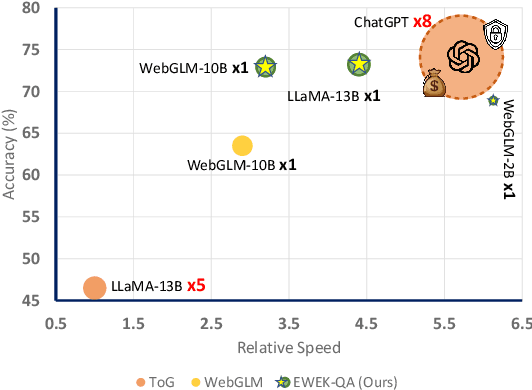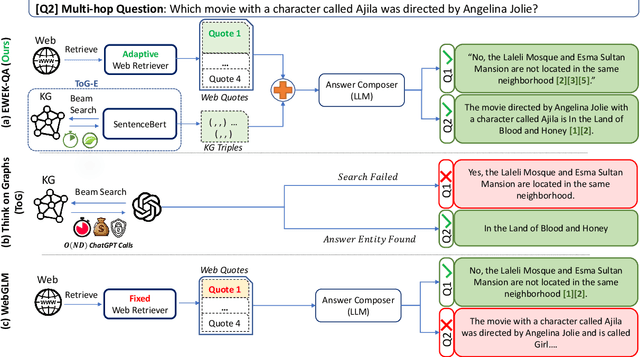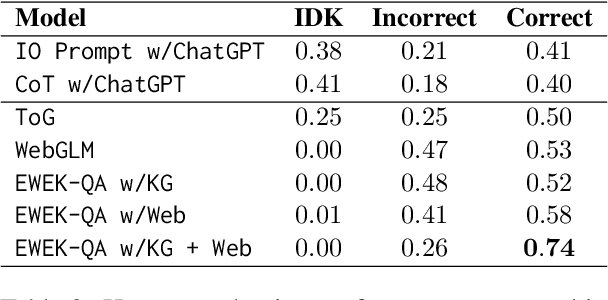Prasanna Parthasarathi
Nested-ReFT: Efficient Reinforcement Learning for Large Language Model Fine-Tuning via Off-Policy Rollouts
Aug 13, 2025Abstract:Advanced reasoning in LLMs on challenging domains like mathematical reasoning can be tackled using verifiable rewards based reinforced fine-tuning (ReFT). In standard ReFT frameworks, a behavior model generates multiple completions with answers per problem, for the answer to be then scored by a reward function. While such RL post-training methods demonstrate significant performance improvements across challenging reasoning domains, the computational cost of generating completions during training with multiple inference steps makes the training cost non-trivial. To address this, we draw inspiration from off-policy RL, and speculative decoding to introduce a novel ReFT framework, dubbed Nested-ReFT, where a subset of layers of the target model acts as the behavior model to generate off-policy completions during training. The behavior model configured with dynamic layer skipping per batch during training decreases the inference cost compared to the standard ReFT frameworks. Our theoretical analysis shows that Nested-ReFT yields unbiased gradient estimates with controlled variance. Our empirical analysis demonstrates improved computational efficiency measured as tokens/sec across multiple math reasoning benchmarks and model sizes. Additionally, we explore three variants of bias mitigation to minimize the off-policyness in the gradient updates that allows for maintaining performance that matches the baseline ReFT performance.
Resona: Improving Context Copying in Linear Recurrence Models with Retrieval
Mar 28, 2025Abstract:Recent shifts in the space of large language model (LLM) research have shown an increasing focus on novel architectures to compete with prototypical Transformer-based models that have long dominated this space. Linear recurrent models have proven to be a viable competitor due to their computational efficiency. However, such models still demonstrate a sizable gap compared to Transformers in terms of in-context learning among other tasks that require recalling information from a context. In this work, we introduce __Resona__, a simple and scalable framework for augmenting linear recurrent models with retrieval. __Resona__~augments models with the ability to integrate retrieved information from the provided input context, enabling tailored behavior to diverse task requirements. Experiments on a variety of linear recurrent models demonstrate that __Resona__-augmented models observe significant performance gains on a variety of synthetic as well as real-world natural language tasks, highlighting its ability to act as a general purpose method to improve the in-context learning and language modeling abilities of linear recurrent LLMs.
Do Robot Snakes Dream like Electric Sheep? Investigating the Effects of Architectural Inductive Biases on Hallucination
Oct 22, 2024



Abstract:The growth in prominence of large language models (LLMs) in everyday life can be largely attributed to their generative abilities, yet some of this is also owed to the risks and costs associated with their use. On one front is their tendency to \textit{hallucinate} false or misleading information, limiting their reliability. On another is the increasing focus on the computational limitations associated with traditional self-attention based LLMs, which has brought about new alternatives, in particular recurrent models, meant to overcome them. Yet it remains uncommon to consider these two concerns simultaneously. Do changes in architecture exacerbate/alleviate existing concerns about hallucinations? Do they affect how and where they occur? Through an extensive evaluation, we study how these architecture-based inductive biases affect the propensity to hallucinate. While hallucination remains a general phenomenon not limited to specific architectures, the situations in which they occur and the ease with which specific types of hallucinations can be induced can significantly differ based on the model architecture. These findings highlight the need for better understanding both these problems in conjunction with each other, as well as consider how to design more universal techniques for handling hallucinations.
Context-Aware Assistant Selection for Improved Inference Acceleration with Large Language Models
Aug 16, 2024Abstract:Despite their widespread adoption, large language models (LLMs) remain prohibitive to use under resource constraints, with their ever growing sizes only increasing the barrier for use. One noted issue is the high latency associated with auto-regressive generation, rendering large LLMs use dependent on advanced computing infrastructure. Assisted decoding, where a smaller draft model guides a larger target model's generation, has helped alleviate this, but remains dependent on alignment between the two models. Thus if the draft model is insufficiently capable on some domain relative to the target model, performance can degrade. Alternatively, one can leverage multiple draft models to better cover the expertise of the target, but when multiple black-box draft models are available, selecting an assistant without details about its construction can be difficult. To better understand this decision making problem, we observe it as a contextual bandit, where a policy must choose a draft model based on a context. We show that even without prior knowledge of the draft models, creating an offline dataset from only outputs of independent draft/target models and training a policy over the alignment of these outputs can accelerate performance on multiple domains provided the candidates are effective. Further results show this to hold on various settings with multiple assisted decoding candidates, highlighting its flexibility and the advantageous role that such decision making can play.
EWEK-QA: Enhanced Web and Efficient Knowledge Graph Retrieval for Citation-based Question Answering Systems
Jun 14, 2024



Abstract:The emerging citation-based QA systems are gaining more attention especially in generative AI search applications. The importance of extracted knowledge provided to these systems is vital from both accuracy (completeness of information) and efficiency (extracting the information in a timely manner). In this regard, citation-based QA systems are suffering from two shortcomings. First, they usually rely only on web as a source of extracted knowledge and adding other external knowledge sources can hamper the efficiency of the system. Second, web-retrieved contents are usually obtained by some simple heuristics such as fixed length or breakpoints which might lead to splitting information into pieces. To mitigate these issues, we propose our enhanced web and efficient knowledge graph (KG) retrieval solution (EWEK-QA) to enrich the content of the extracted knowledge fed to the system. This has been done through designing an adaptive web retriever and incorporating KGs triples in an efficient manner. We demonstrate the effectiveness of EWEK-QA over the open-source state-of-the-art (SoTA) web-based and KG baseline models using a comprehensive set of quantitative and human evaluation experiments. Our model is able to: first, improve the web-retriever baseline in terms of extracting more relevant passages (>20\%), the coverage of answer span (>25\%) and self containment (>35\%); second, obtain and integrate KG triples into its pipeline very efficiently (by avoiding any LLM calls) to outperform the web-only and KG-only SoTA baselines significantly in 7 quantitative QA tasks and our human evaluation.
CHARP: Conversation History AwaReness Probing for Knowledge-grounded Dialogue Systems
May 24, 2024



Abstract:In this work, we dive deep into one of the popular knowledge-grounded dialogue benchmarks that focus on faithfulness, FaithDial. We show that a significant portion of the FaithDial data contains annotation artifacts, which may bias models towards completely ignoring the conversation history. We therefore introduce CHARP, a diagnostic test set, designed for an improved evaluation of hallucinations in conversational model. CHARP not only measures hallucination but also the compliance of the models to the conversation task. Our extensive analysis reveals that models primarily exhibit poor performance on CHARP due to their inability to effectively attend to and reason over the conversation history. Furthermore, the evaluation methods of FaithDial fail to capture these shortcomings, neglecting the conversational history. Our findings indicate that there is substantial room for contribution in both dataset creation and hallucination evaluation for knowledge-grounded dialogue, and that CHARP can serve as a tool for monitoring the progress in this particular research area. CHARP is publicly available at https://huggingface.co/datasets/huawei-noah/CHARP
Towards Practical Tool Usage for Continually Learning LLMs
Apr 14, 2024Abstract:Large language models (LLMs) show an innate skill for solving language based tasks. But insights have suggested an inability to adjust for information or task-solving skills becoming outdated, as their knowledge, stored directly within their parameters, remains static in time. Tool use helps by offloading work to systems that the LLM can access through an interface, but LLMs that use them still must adapt to nonstationary environments for prolonged use, as new tools can emerge and existing tools can change. Nevertheless, tools require less specialized knowledge, therefore we hypothesize they are better suited for continual learning (CL) as they rely less on parametric memory for solving tasks and instead focus on learning when to apply pre-defined tools. To verify this, we develop a synthetic benchmark and follow this by aggregating existing NLP tasks to form a more realistic testing scenario. While we demonstrate scaling model size is not a solution, regardless of tool usage, continual learning techniques can enable tool LLMs to both adapt faster while forgetting less, highlighting their potential as continual learners.
Language Model-In-The-Loop: Data Optimal Approach to Learn-To-Recommend Actions in Text Games
Nov 13, 2023



Abstract:Large Language Models (LLMs) have demonstrated superior performance in language understanding benchmarks. CALM, a popular approach, leverages linguistic priors of LLMs -- GPT-2 -- for action candidate recommendations to improve the performance in text games in Jericho without environment-provided actions. However, CALM adapts GPT-2 with annotated human gameplays and keeps the LLM fixed during the learning of the text based games. In this work, we explore and evaluate updating LLM used for candidate recommendation during the learning of the text based game as well to mitigate the reliance on the human annotated gameplays, which are costly to acquire. We observe that by updating the LLM during learning using carefully selected in-game transitions, we can reduce the dependency on using human annotated game plays for fine-tuning the LLMs. We conducted further analysis to study the transferability of the updated LLMs and observed that transferring in-game trained models to other games did not result in a consistent transfer.
Measuring the Knowledge Acquisition-Utilization Gap in Pretrained Language Models
May 24, 2023Abstract:While pre-trained language models (PLMs) have shown evidence of acquiring vast amounts of knowledge, it remains unclear how much of this parametric knowledge is actually usable in performing downstream tasks. We propose a systematic framework to measure parametric knowledge utilization in PLMs. Our framework first extracts knowledge from a PLM's parameters and subsequently constructs a downstream task around this extracted knowledge. Performance on this task thus depends exclusively on utilizing the model's possessed knowledge, avoiding confounding factors like insufficient signal. As an instantiation, we study factual knowledge of PLMs and measure utilization across 125M to 13B parameter PLMs. We observe that: (1) PLMs exhibit two gaps - in acquired vs. utilized knowledge, (2) they show limited robustness in utilizing knowledge under distribution shifts, and (3) larger models close the acquired knowledge gap but the utilized knowledge gap remains. Overall, our study provides insights into PLMs' capabilities beyond their acquired knowledge.
Deep Learning on a Healthy Data Diet: Finding Important Examples for Fairness
Nov 25, 2022



Abstract:Data-driven predictive solutions predominant in commercial applications tend to suffer from biases and stereotypes, which raises equity concerns. Prediction models may discover, use, or amplify spurious correlations based on gender or other protected personal characteristics, thus discriminating against marginalized groups. Mitigating gender bias has become an important research focus in natural language processing (NLP) and is an area where annotated corpora are available. Data augmentation reduces gender bias by adding counterfactual examples to the training dataset. In this work, we show that some of the examples in the augmented dataset can be not important or even harmful for fairness. We hence propose a general method for pruning both the factual and counterfactual examples to maximize the model's fairness as measured by the demographic parity, equality of opportunity, and equality of odds. The fairness achieved by our method surpasses that of data augmentation on three text classification datasets, using no more than half of the examples in the augmented dataset. Our experiments are conducted using models of varying sizes and pre-training settings.
 Add to Chrome
Add to Chrome Add to Firefox
Add to Firefox Add to Edge
Add to Edge